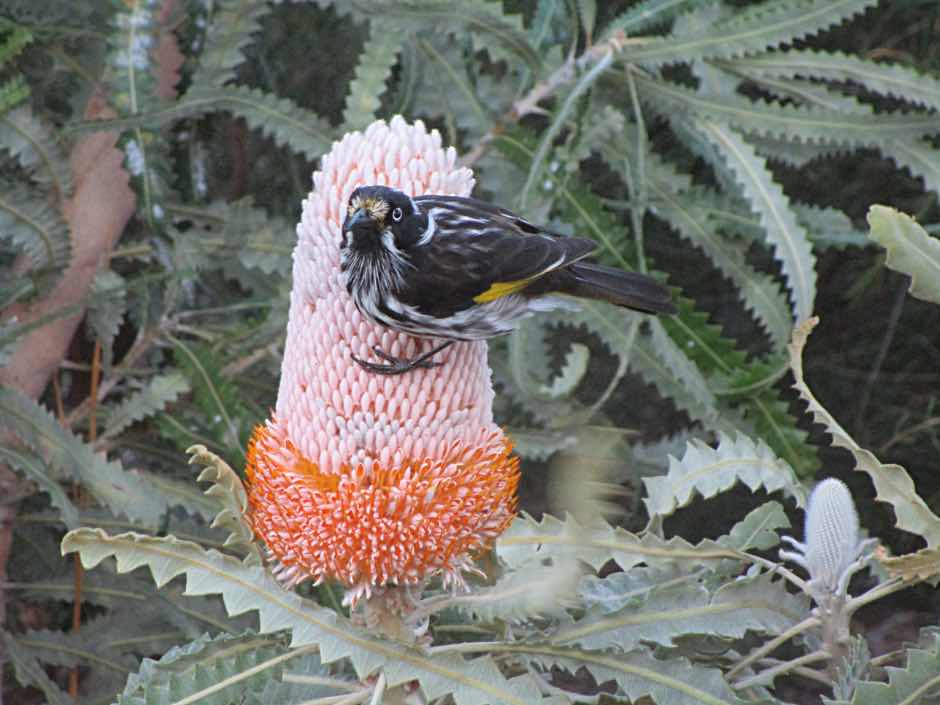
|
|
|
|

|
Photo Canon Ixus 190, 2022/02/20 |
I was very fortunate to get these photos. We just pulled up at our home in our car and this little bloke was feasting on the nectar of the Banksia.
The scientific name of the New Holland honeyeater is Phylidonyris novaehollandiae. The plant seems to be Banksia victoriae. The image and description on Wikipedia fits well except the leaves on this specimen are up to 40cm rather than the '15 to 30cm' of Wikipedia. It is apparently one of the most popular Banksias in local gardens.
Mandurah is a great place for viewing many species of birds, particularly water birds. I've images of Mandurah water birds elsewhere on this page and on another on this site.
Peel estuaryLen Howard Reserve, in the Peel Estuary region |
The area involved
|
|---|

|
The Len Howard Conservation Park, I believe, is roughly the grey-green strip running from bottom centre to the upper right of this image. Mandurah Quay is in the upper right corner of the image (at the word 'Boundary' on the far right). There is an unsealed walking path that runs from Nature's Eye Shelter (bottom, left of centre) along near the coast of Collins Pool to Mandurah Quay. There are concreted walking/cycling paths on the northern boundary of the conservation park.
While I have called the swamp 'ephemeral' above, after seeing how long it is flooded (by late July 2022) it would be more accurately called 'seasonal'. |
Sunrise over the Peel lagoon |

|
|
Seen while on an early morning bike ride in summer, the Peel lagoon; from the walking trail in the Len Howard Conservation Park.
Photo iPhone 11 pro, wide angle lens, 1.54mm, 2023/02/05 |
A calm summer's morning on the Peel - from the Len Howard Conservation Park trail - five photos |

|
|
The Peel lagoon on an exceptionally calm morning; from the walking trail in the Len Howard Conservation Park.
Photo iPhone 11 pro, wide angle lens, 1.54mm, 2023/01/23 |

|
|
Vegetation bordering the Peel estuary in Len Howard CP, as viewed from the walking trail.
Photo iPhone 11 pro, wide angle lens 1.54mm, 2023/01/23 |
The Peel is ideal for crabbing, it is very shallow and has a sandy bottom, and a day like this with glassy water surface allows the crabs to be seen easily.
Photo iPhone 11 pro, telephoto lens, 6mm, 2023/01/23
Further north
The smaller trees are paperbarks (Melaleucas), the large one possibly a marri (Corymbia calophylla)
Photo iPhone 11 pro, 4.25mm standard lens, early morning 2023/01/01
The bird in the upper left is an Australian white ibis, Threskiornis molucca.
Photo iPhone 11 pro, 6mm standard lens, early morning 2023/01/01
Photo 2022/11/02, iPhone 11 Pro, standard camera 4.25mm focal length
Photo 2022/11/20, iPhone 11 Pro, standard camera 4.25mm focal length |
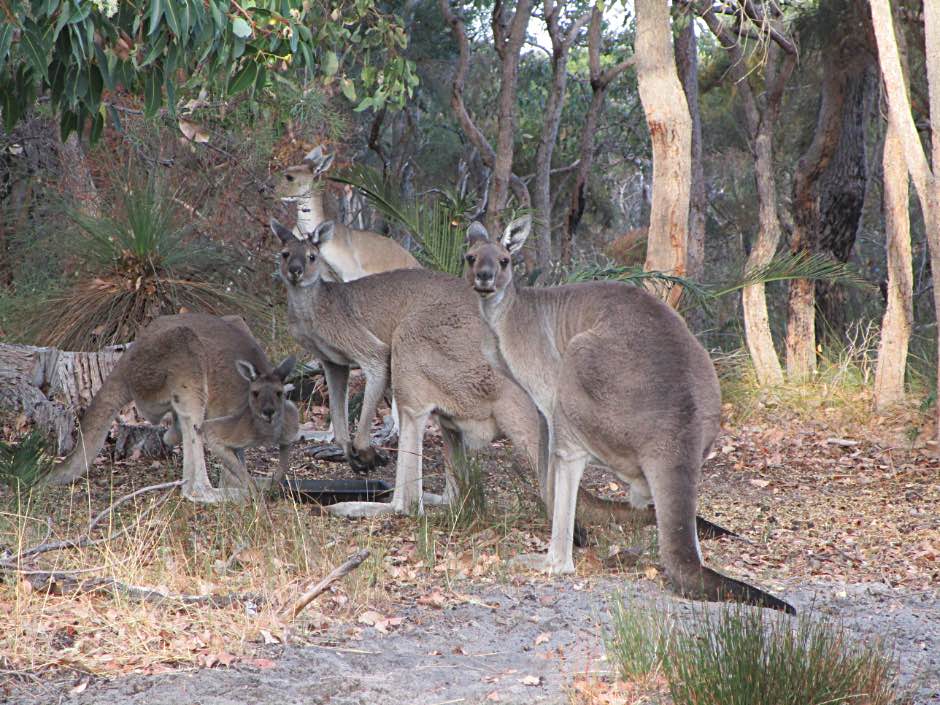
|
|
Kangaroos at a feeding station that someone maintains adjacent to the Len Howard CP
The kangaroos that live in the Len Howard CP are very relaxed around people. Many times we have seen them grazing on someone's front lawn. I've seen one hop through a front gate to do some grazing in mid morning. Photo taken 2022/03/16, Canon Ixus 190 |
Osprey in Len Howard Conservation Park
Photo Canon Ixus 190, 2022/02/18
|
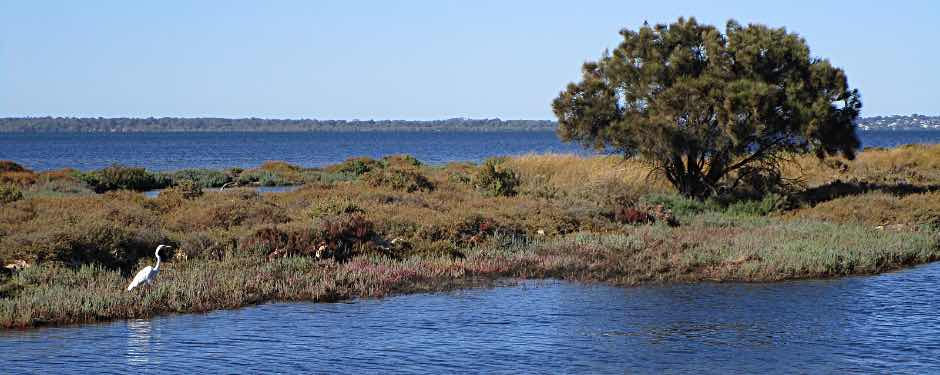
|
|
An Egret, either a little egret, Egretta garzetta or a great egret, Egretta alba, in the Peel wetlands; Collins Pool in the background.
(I believe I've seen both little and great egrets in the area.)
Photo Canon Ixus 190, 2022/02/18 |
There is a photo of many spoonbills in their communal roosting area on another page on this site.
Photo Canon Ixus 190, focal length 43mm, 2022/07/06
There is one or more of these birds in an area on the eastern side of the big seasonal paperbark swamp. Photo Canon Ixus 190, focal length 43mm, 2022/07/20 |
Waterbird roosting areaThis particular lagoon is at the extreme northern corner of the Len Howard Conservation Park. It always contains a great many roosting water birds of many species. |

|
There are many dead trees in the conservation park; the most likely cause would seem to me to be increased salinity possibly due to reduced flushing with fresh water resulting from lower rainfalls. Photo Canon Ixus 190, early morning 2022/02/18 |
Shorebird or Waterbird?The following is extracted from a Mandurah Environment and Heritage Group pamphlet..."Waterbirds are basically birds that are mostly seen feeding, breeding or resting in or around water. The shorebirds are a specific genetic grouping of waterbirds, comprising of the Sandpipers and Plovers, within which there are sub-groups such as the Stilts, Avocets, Stints, Godwits, Curlews, Dotterels and Lapwings. The Egrets, Herons, Ibises, Spoonbills, Ducks, Cormorants, Terns, Grebes, Pelicans, Swans and a few others are not shorebirds but simply waterbirds." |
The Duck PondThis little lagoon is close to my home. As it does not seem to have any official name and can contain hundreds of ducks I've taken to calling it the Duck Pond. |
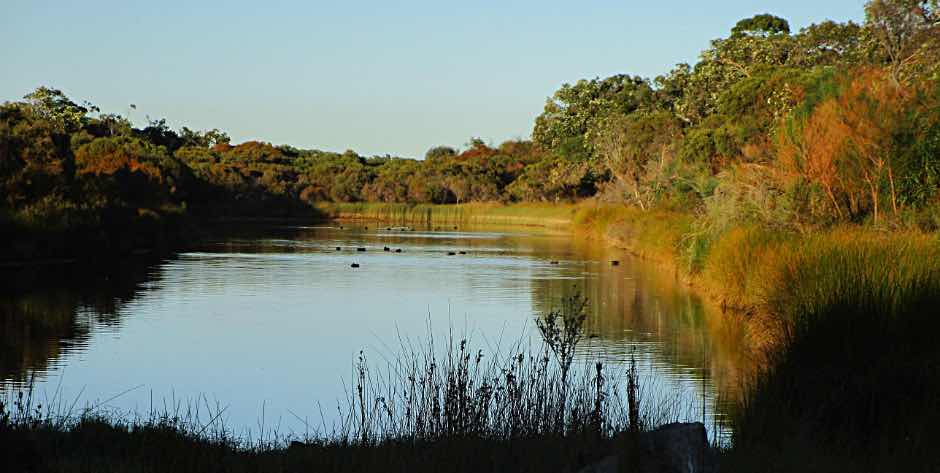
|
|
A pond in the Len Howard reserve. The water birds in the middle distance are Pacific black ducks (Anas superciliosa, they can be identified by the black steak through the eye area), at least some of those in the distance are grey teal.
This pond is impossible to access in winter without wading through water. I found that the water level had fallen enough by early November 2022 for me to access one end of it without wading through water. Photo Canon Ixus 190, 2022/02/22 |
Photo Canon Ixus 190, 2022/03/27
Hardenbergia probably comptoniana on the edge of the Len Howard reserve.
An evening view looking west from the Nature's Eye shelter area taken when I placed the first dog and kangaroo watering point. The bright 'star' is probably Venus.
I continue to be impressed at the capabilities of the iPhone cameras. It would be quite impossible to take a photo like this hand-held with a conventional camera. |

|
|
An early morning view toward the rising Sun from the lagoon foreshore reserve east of the Novara boat ramp.
A distinctively Australian Casuarina tree on the right, Melaleucas further away; the Darling Scarp in the distance.
Photo 2022/05/28, iPhone 11 Pro, 4.25mm (standard) focal length.
On a previous occasion I sat on the bench between the two trees on the right, a car was parked some distance on my left. The driver then moved his cat to about its position in this photo and, again, turned his headlights on, shining them on me. He left them on for some minutes, not pleasant for me. Weird.
Photo 2022/07/18, iPhone 11 Pro, 4.25mm (standard) focal length.
On a day with scattered showers and short sunny periods. Note the dead paperbark trees, killed, it would seem, by the increasing salinity of the Peel estuary, due to climate change.
Photo, iPhone 11 Pro, ultra-wide lens, 1.54mm focal length
Photo, iPhone 11 Pro, telephoto lens, 6mm focal length
Swan family in the Len Howard CP |
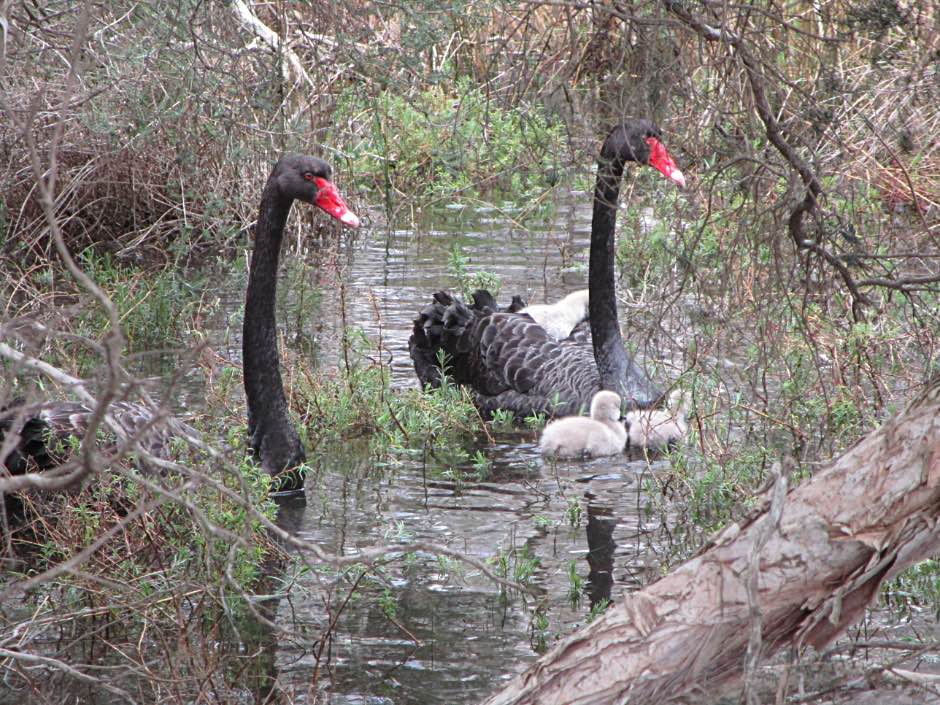
|
|
A swan family in the Len Howard CP just south of Mandurah Quay. They seemed to be sheltering from the wind, which was exceptionally strong on the day. They may also have been sheltering their cygnets from predators; I'd been told that pelicans predate cygnets and ducklings.
There were another couple of pairs of swans not far away. Photo Canon Ixus 190, 2022/08/03 |
Big seasonal paperbark swamp (BSPS)
|
|
The Google Earth image on the right, dated 2018/11/14, shows water in two places in the swamp. It seems that at most times of a typical year there is no surface water present.
I have spent many hours controlling fleabane and onion weed in this area through much of 2022 and up to at least September of 2023. It and the Len Howard Conservation Park are my favourite places within a kilometre or so of my home.
|
|
|
|
|
Curiously there is very little middle story undergrowth in the BSPS while the part of the Len Howard Conservation Park that is close to the Peel lagoon is densely covered with undergrowth, to the point where much of it is difficult to walk through. In the BSPS there are grasses and low groundcovers, some rushes in places and there are the trees; very few shrubs. There are some grass trees (Xanthorrhoeas) and Zamia palms (Macrozamia riedlei) in the more open areas.
|
Photo iPhone 11 pro, 4.25mm standard lens, early morning 2023/01/02.
|
|
|
Western grey kangaroo (Macropus fuliginosus)
Photo Canon Ixus 190, 2025/02/28
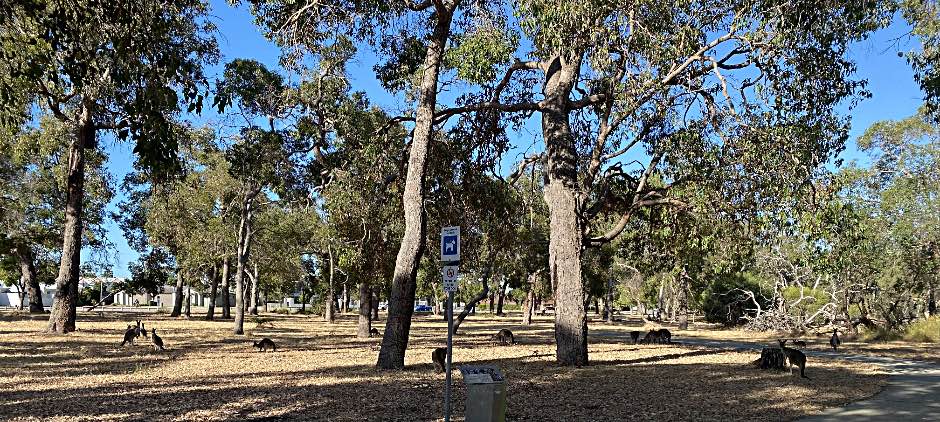
|
|
The Big Paperbark Swamp Mob in the northern end of the BSPS.
Photo iPhone 11 Pro, standard lens, 2023/01/23 |

|
|
Most of the Big Paperbark Swamp Mob. There are at least 24 kangaroos in the photographed area.
Photo iPhone 11 Pro, telephoto lens, 6mm, 2022/07/26 |
The paperbark swamp through the seasons
A particularly big paperbark tree in the 'big seasonal paperbark swamp' (see Google Earth image, above). It is probably a swamp paperbark, Melaleuca rhaphiophylla, but possibly a saltwater paperbark, Melaleuca_cuticularis.
Photo 2022/04/27, iPhone 11 Pro, wide angle camera
The swamp begins to fill
A view of a part of the paperbark swamp that was flooded for a part of the winter of 2022. The swamp was not full at this point. The swamp area is home to 25 or so kangaroos, possibly more. They are not shy, a person can walk within several metres of them at times. Photo iPhone 11 pro, 2022/06/22
I've kept some records of when the BSPS starts and stops overflowing in the time I've lived in the vicinity on another page on this site.
Duckweed grows on the water in the paperbark swamp; winter of 2022 |
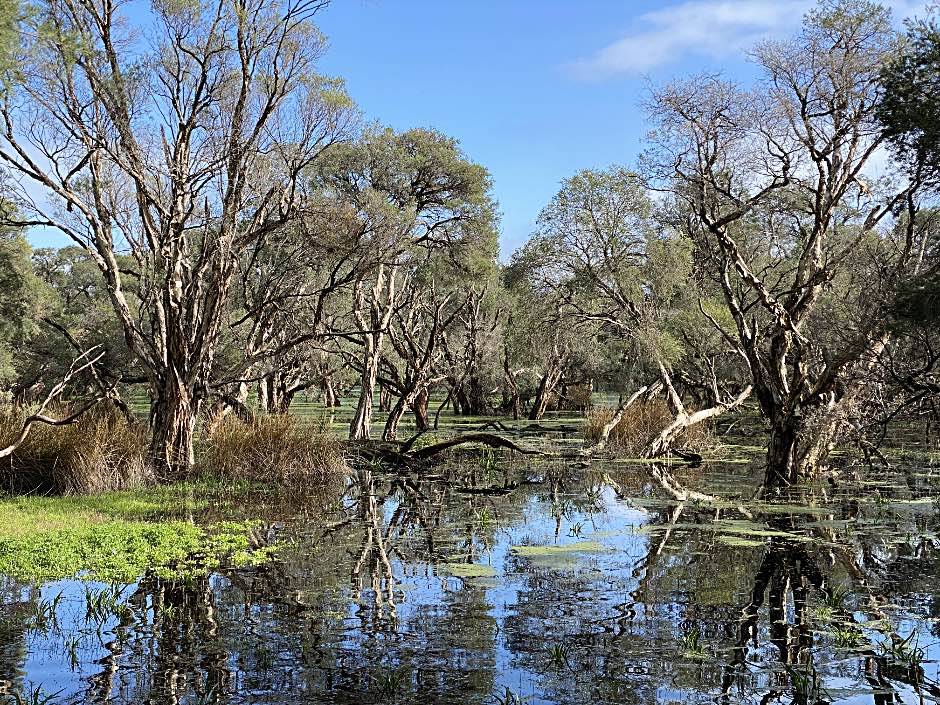
|
|
Erskine had a wet winter, at least up to the time of photographing this, 2022/07/24. By my records there had been 129mm of rain in May, 148mm in June and 109mm up to 24th of July. Consequently the swamp was full and overflowing into the main estuary pool. (I don't seem to have recorded when the swamp started overflowing, it was probably at least a couple of weeks before I took this photo, but surface flow into the estuary stopped on 2022/09/28.)
The floating plant is common duckweed, Lemna minor. It is not native to Australia. Photo iPhone 11 Pro, focal length 6mm (telephoto), 2022/07/24 |
From a distance, and in the lower definition version of these photos, the duckweed could be mistaken for algae.
Duckweed close-up
Photo iPhone 11 Pro, standard lens (4.25mm), 2022/08/04
The leaves (if that is what they were) seemed smaller and more fleshy than in the above photo. Perhaps they were fruits rather than leaves?
Photo Canon Ixus 190.
Mandurah Quay area, Peel Estuary |

|
|
Looking across the Peel estuary on a misty morning, Boundary Island on the right.
Photo iPhone 11 Pro, telephoto lens, focal length 6mm, 2022/06/02.
This is a very attractive place to walk, and a very popular place for dog walking. Photo iPhone 11 Pro, standard lens, 4.25mm focal length, 2022/08/11 |
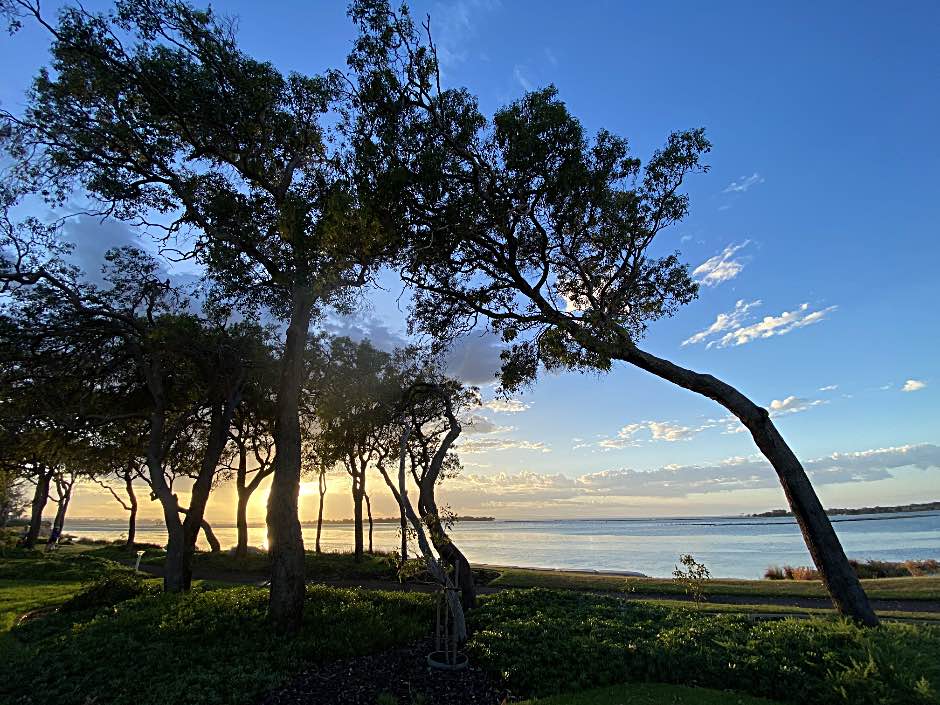
|
|
Sunrise over the Peel, seen from an early morning bike ride, a little to the north of Mandurah Quay.
Photo iPhone 11 pro, wide angle lens, 1.54mm, 2023/02/05 |
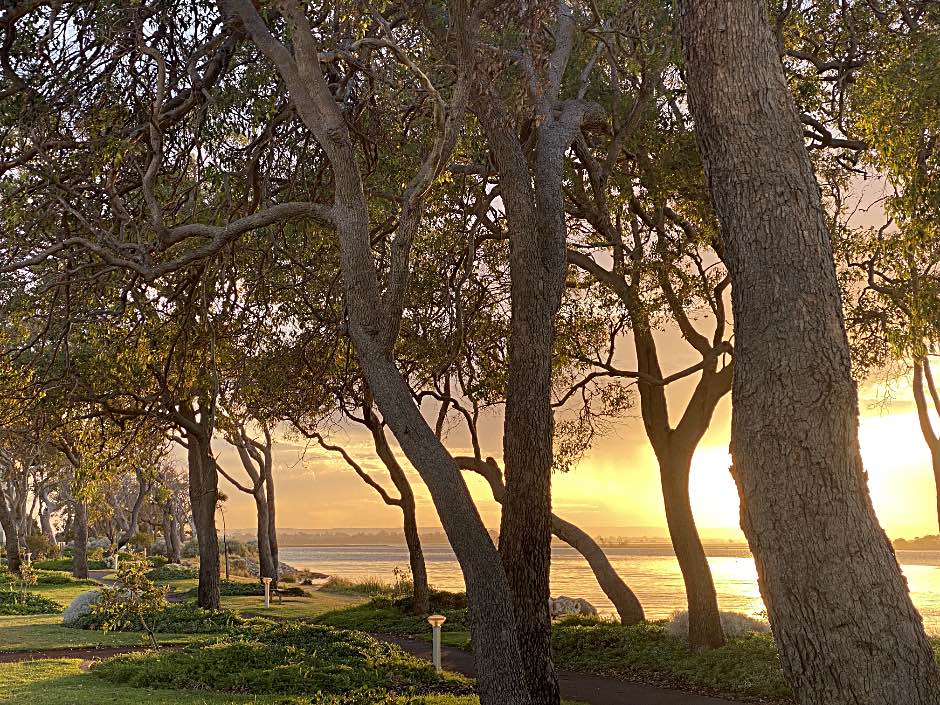
|
|
Again, sunrise over the Peel, seen from an early morning bike ride, a little to the north of Mandurah Quay and a very little further north than the previous image.
Photo iPhone 11 pro, telephoto lens, 6mm, 2023/02/05 |
East side of main channel, Soldiers Cove
There is a path along the channel for rather over half the distance between the two bridges.
Novara Beach Reserve, Peel Estuary |
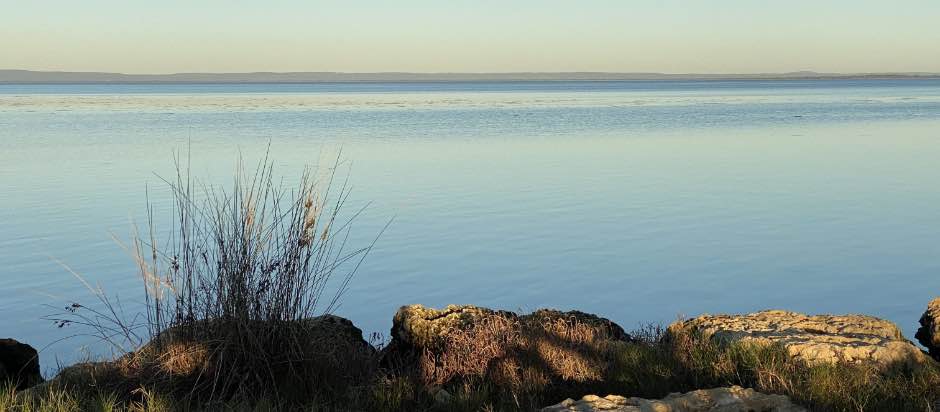
|
|
The Peel lagoon from the Novara Reserve.
On the left is, I think, a club rush (Ficinia nodosa).
Mount WilliamOn the horizon in the high definition version of the photo above, to the right the barely visible tiny hump, I believe, is Mount William. From much of the Peel lagoon area it is visible as a small but distinctive hill on the Darling Scarp. Mount William is 484 metres high, Mt Saddleback, south of Boddington, at 593 metres, is the highest point on the Darling Range.
I did climb the only one of the other towers that had an accessible ladder, but found the view from there to be disappointing too, with nothing but featureless bush nearby and any interesting areas off in the far distance.
Coincidentally there is another Mount William in Australia, it happens to be the highest mountain in The Grampians of Victoria. It is a far more impressive mountain and the views from the top are magnificent.
The Novara Beach Reserve is west of the Len Howard CP and Novara boat ramp. It has attractive lawns, barbecue areas, ponds and beaches such as this. Occasionally a bandicoot can be seen near one of the many patches of dense native bush. Our dog Monty is in the foreground in the photo. Photo 2022/04/27, iPhone 11 Pro, standard focal length camera
Photo Canon Ixus 190, 2022/10/15
Serpentine area, Peel EstuaryBandicoot
Seen just below the boardwalk, northern end of Riverside Gardens Reserve, Greenfields, Mandurah. The area is densely populated (with humans), there are lots of pet dogs, many of which are walked off their leashes. I've seen a few free-roaming cats. I don't think I've ever seen a wild bandicoot in South Australia. It has surprised me that they have managed to persist in this area; the very dense undergrowth in a number of places would certainly be an important factor in giving them protection.
Photo Canon Ixus 190, 2022/02/28
Serpentine area on a smokey morning |

|
|
The Serpentine on a smokey morning near St Ives Lifestyle Village. The smoke added a very pleasing 'atmosphere' to the views on this morning.
Photo iPhone 11 Pro, wide angle camera (focal length 1.54mm) 2022/05/09
The smoke was probably from a controlled fire load reduction burn.
Photo iPhone 11 Pro, wide angle camera (focal length 1.54mm) 2022/05/09
Dawesville Foreshore Reserve
Photo iPhone 11 Pro, telephoto lens, 6mm focal length
Unnamed reserve behind our house
This park or reserve is one of the areas that I have been working on with the aim of controlling feral weeds including fleabane and false onion weed.
Photo 2022/11/04, iPhone 11 Pro, standard camera 4.25mm focal length
Photo 2022/11/04, iPhone 11 Pro, standard camera 4.25mm focal length
Mandurah centre
When it wasn't stealing food it was chattering loudly. Rhipidura leucophrys, common name Willie wagtail. They are one of the more common of Australian birds and often show very little fear of people, or of anything else.
Photo iPhone 11 Pro, telephoto lens, focal length 6mm.
Nankeen night herons
Photo Canon Ixus 190, focal length 18mm, 2022/03/01.
Photo Canon Ixus 190, focal length 37mm, 2023/02/12
On this particular morning there were eight night herons in the area for a short while, in front of The Bay Cafe, Mandurah. A fisherman who comes here frequently ('every day' he told me) feeds them and has made at least two very tame. Photo Canon Ixus 190, focal length 43mm, 2023/03/05 |

|
|
Looking west from the footbridge at Dolphin Quay shortly after sunrise
Photo iPhone 11 Pro, 2022/05/07, wide angle lens, focal length 1.54mm
The Canals
Bicycling in Mandurah is very pleasant, there are many shared (bicycle/pedestrian) paths and many attractive parks and gardens. (I am trying to enhance the attractiveness of several areas). There are weeds in many of the parks, one of particular note is tall fleabane partly because it could be fairly easily controlled by hand pulling if only a few people wanted to make a little effort at times. One of my projects is controlling fleabane in parks near my home.
Photo iPhone 11 Pro, telephoto lens, focal length 6mm.
Mandurah ocean beaches |
|
Mandurah has some beautiful beaches. Limestone reefs close to the shore in many areas do make getting into the water for a swim tricky, especially when there is a larger than usual surf, but there are a number of places where there is no reef, just sand.
The photos below were taken on the beaches of Endeavour Island, between the natural inlet to the Peel Lagoons and the Dawesville Channel. See also a section on the Mandurah ocean beach on my Peel Estuary and Mandurah Observations page. |
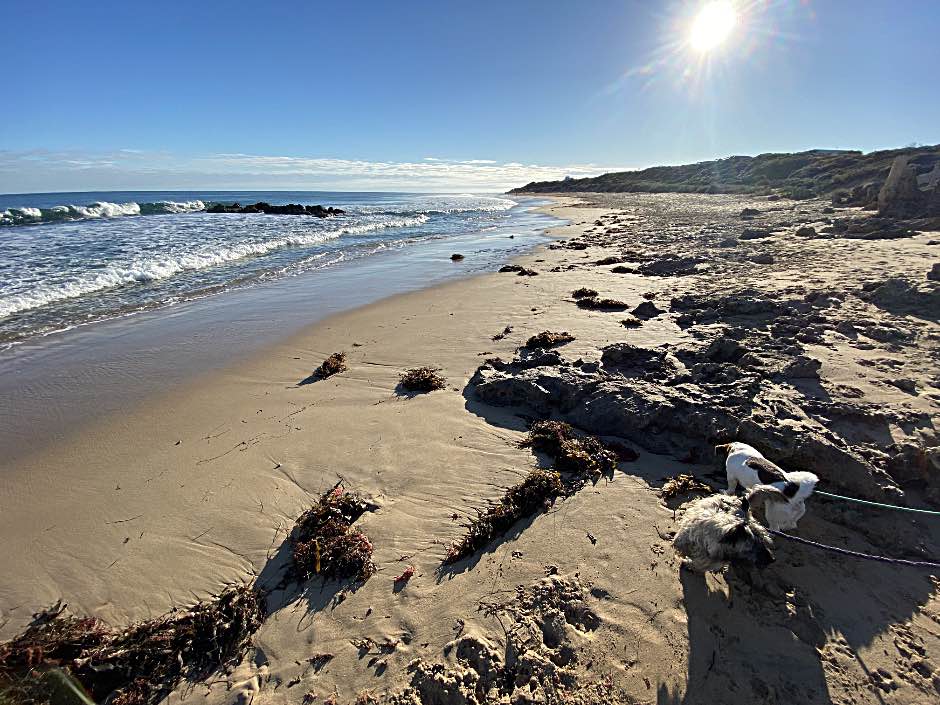
|
|
Dogs on or off leash are allowed on a number of the beaches. Here Haggis (closer to the camera) and Monty are about to be set loose.
Photo 2022/05/31, iPhone 11 Pro, extra wide angle lens, focal length 1.54mm |
Mandurah is a very popular place for boating. I often see people towing their fishing boat off for an outing. There are also many larger and, no doubt far more expensive boats (power and sailing) to be seen in the various marinas. The remarkable thing about the big boats is that I very rarely see them when I visit the beach (the lagoons are too shallow for large sailing boats); my impression is that they are more for show or for impressing business associates than for use. I've written about this conspicuous consumption on another page.
Photo 2023/05/05, iPhone 11 Pro, telephoto lens, focal length 6mm
Photo iPhone 11 Pro, standard lens, 4.25mm fl, 2022/03/29
Mandurah area generally |
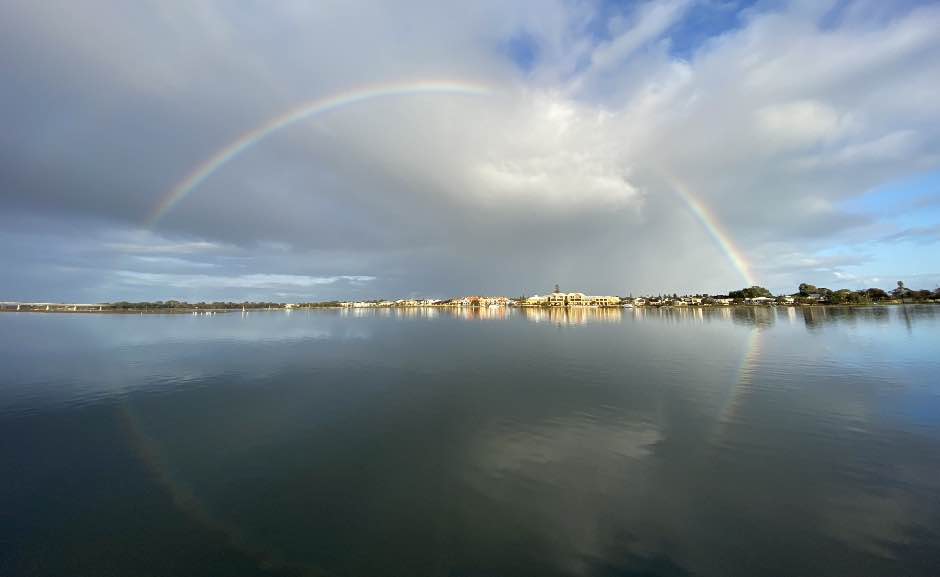
|
|
A rainbow over the Peel estuary photographed from the shared-use path on the east side of the channel, south of the town bridge.
Photo iPhone 11 Pro, wide angle lens, 1.54mm focal length |
The smaller branches have been cut off, I suppose so that they don't drop off and make the street untidy. I suspect that the bulk of the tree has been left because it has hollows that serve as homes to wildlife. There is a shortage of nesting hollows in Australia because so many trees have been cut down for one reason or another. It takes many decades for a tree to develop hollows suitable for nesting.
There was at least one pair of galahs living in one of the hollows in this tree.
Photo iPhone 11 pro, 2022/06/16
Grasstrees
I gather the WA grass trees are mostly either Xanthorroea preissii or X gracilis. I'd guess that these are the former. The remarkable Kingia australis looks superficially similar, yet is unrelated.
Sundew
Sundews are carnivorous plants that trap tiny insects in the sticky substance at the ends of the little hairs surrounding the leaves. They then digest the insects and absorb nutrients from them, particularly the nitrogen. Photo Canon Ixus 190, 2022/06/13
I've photographed sundews in Spring Gully Conservation Park in the Clare Valley of South Australia too.
Photo iPhone 11 Pro, standard lens, 2023/08/02
Mandurah's Giants |
|
Danish sculptor Thomas Dambo built six wooden giants, five were constructed in the Mandurah area and one at Subiaco in Perth. The wood that was used in the construction was mainly recycled.
By the time I added the image below to this page my wife and I had visited all six. Not long after this, one of the giants (at Coodanup) was burned by low-life. |
Halls Head Giant, Santi Ikto
I was out for an early morning bike ride and took this photo soon after sunrise. I had spent some time taking a half a dozen rolls of toilet paper off the statue. The Mandurah Christmas pageant had taken place the previous evening and much of the population of the town was in central Mandurah to see it. Quite possibly the people who wrapped the statue in toilet paper had taken advantage of the minimal chance of interruption to do their work.
Photo, iPhone 11 pro, standard lens, 4.25mm focal length, 2022/12/03, 5:45am
Photo, iPhone 11 pro, standard lens, 4.25mm focal length, 2023/01/11, 19:04hrs
It happens that this giant is adjacent our favourite dog-walking beach. It's also on a shared-use cycling/walking trail that goes about three kilometres through the sand dunes beside the beach.
|
The Halls Head giant welcoming the sunrise
|
|---|

|
|
Something I greatly enjoy in my old age is an early morning bike ride before there is much traffic on the roads. On this morning it happened that I came to the Halls Head giant when the earliest reddening was showing in the east.
Photo iPhone 11 Pro, 2023/04/30, extra wide angle lens, focal length1.54mm |
Coodanup Giant, Vivi Cirklestone
It was reported on the ABC (2022/12/19) that there were hopes that the giant could be rebuilt. (It was rebuilt, see below.)
Coodanup Giant_mark_2, Yaburgurt Cirklestone
Denece and I just happened to visit when there was a bit of ceremony going on including a smoking ceremony and some Aboriginal dancing. The man in the grey coat in the photo is Mandurah Mayor Ryse Williams. Yaburgurt seems to be looking at the small group. I was told that the name Yaburgurt had some significance to the local Aboriginies and that the Aboriginal Corporation had given permission for the name to be used for this giant.
Photo, iPhone 11 pro, telephoto lens, 6mm focal length, 2023/05/27
Dawesville Giant, Seba
Overlooking the Dawesville channel. I believe this giant is named Seba (or Seba's Song). Photo, iPhone 11 pro, standard lens, 4.25mm focal length, just after sunrise, 2023/01/29, 5:45am
On this particular day I had decided to go for a very long walk, and started very early in the morning. Unlike my first visit (see below) there were only a couple fishers nearby this time.
This visit was this only a week or so after the Giants trail was officially opened. That was probably a mistake because there was very limited parking anywhere nearby and a big traffic jam - which we managed to mostly avoid by walking about twice as far as would have been necessary at some other time.
Lake Clifton Giant, Jyttes Hytte
The giant was quite a long walk from the thrombolite viewing area. On the way Denece and I were impressed at the huge number of jewel spider (Austracantha minax) webs in the bush beside the track. They must catch countless millions of small insects, most likely including (a majority of?) mosquitos.
Photo, iPhone 11 pro, standard lens, 4.25mm focal length, 2022/12/02
Subiaco Giant, Billie Bob
I suspect that the reasoning was that Perth people would visit the Subiaco Giant because it was not far away, then would decide they needed to see the other giants, and visit Mandurah.
Photo, iPhone 11 pro, standard lens, 4.25mm focal length, 2022/11/23
Marlee Reserve Giant, Little Lui
Denece and I walked around quite a large part of the reserve before we found the giant. We came across a large patch of fleabane on our walk. Fleabane is a very widespread and invasive weed in the Mandurah area; I have made a project of removing it where it occurs on paths or reserves within a kilometre or so of my home.
Photo, iPhone 11 pro, standard lens, 4.25mm focal length, 2022/11/15
Marlee Reserve
Photo iPhone 11 Pro, 1.54mm wide angle lens
Photo iPhone 11 Pro, wide angle lens fl 1.45mm, 2023/09/24
Black Swan Lake Reserve, Lakelands
Photo iPhone 11 Pro 4.26mm standard lens, 2023/10/27
Unfortunately the Black Swan Lake Reserve is infested with the invasive weed fleabane. I've written more on this on another page on this site. The weed would not be very difficult to control if someone was willing to make a consistent effort in their spare time.
Photo iPhone 11 Pro 6mm telephoto lens, 2023/10/27
Photo iPhone 11 Pro 6mm telephoto lens, 6mm fl, 2024/01/09
I rode my bike the length of Marlee Reserve, through the underpass and along the eastern side of Black Swan Lake. Only a part of the path is paved, but it is all in fair condition.
Photo iPhone 11 Pro 6mm telephoto lens, 6mm fl, 2024/01/21
Drone images of Black Swan Lake
Interestingly this death seems to have been fairly recent. In the Google Earth image of the same area recorded November 2018, that I have inserted below, most of the trees were still alive.
On another page I have commented on the tree deaths in the seasonal swamps near the Peel lagoon.
Click on the image for the higher resolution version. That provides about the highest resolution I could get from Google Earth. In the Google Earth image, while a number of tree near the central area appear to be dying, most seem to still be alive. I can only speculate that it is likely to be the drying climate that has killed the trees, most likely through increasing salinity due to reduced flushing of salts.
North is at the top of this image.
My back yard
The first birds we saw eating the seed block were ring-necked parrots.
This and the following two photos were taken on my iPhone 11 Pro on 2023/05/18.
Galahs are considered to be cockatoos. So far as I know, cockatoos are just larger forms of parrots and these galahs were bigger than the ring-necked parrots.
Finally, our dogs chased away the corellas, and after a short time the ring-necked parrots came back.
Just beyond my back yardThe eight photos below were taken in several little reserves within a few hundred metres of my home in Erskine, Mandurah, all on a short early morning walk. They are included on this page more for, I hope, pictorial interest than botanical or ecological interest.
Old dried Banksia seed pod. I've always found it curious that while there must be a very large number of inflorescences in the big Banksia flowers, there are only a few seeds that seem to come to maturity in each.
Photo iPhone 11 Pro, standard lens 4.25mm focal length 2023/10/28
Photo iPhone 11 Pro, standard lens 4.25mm focal length 2023/10/28
Jarrah, together with marri (Corymbia calophylla) and tuart (Eucalyptus gomphocephala) are the most common large endemic Eucalypt trees in the Mandurah area.
Photo iPhone 11 Pro, standard lens 4.25mm focal length 2023/10/28
Photo iPhone 11 Pro, standard lens 4.25mm focal length 2023/10/28
Xanthorrhoea leaves
More complete photos on grass trees (aka yaccas or yackas or yakkas) are on this page here and here and on other pages here, here, here, here and especially here. At this point I will probably not surprise the reader if I say that Xanthorrhoeas fascinate me. The plant is very slow growing, taking a decade or more to produce a trunk which then grows about a centimetre a year. But the seed spike can grow more than ten centimetres in a day, as I've recorded here.
Photo iPhone 11 Pro, telephoto lens 6mm focal length 2023/10/28
The flowers on the flower spike produce a lot of nectar. It can be licked off and, I believe, was once a favourite sweet treat for Australian Aborigines.
Photo iPhone 11 Pro, standard lens 4.25mm focal length 2023/10/28
Photo iPhone 11 Pro, standard lens 4.25mm focal length 2023/10/28
Araluen Botanic Park, in the Perth Hills |
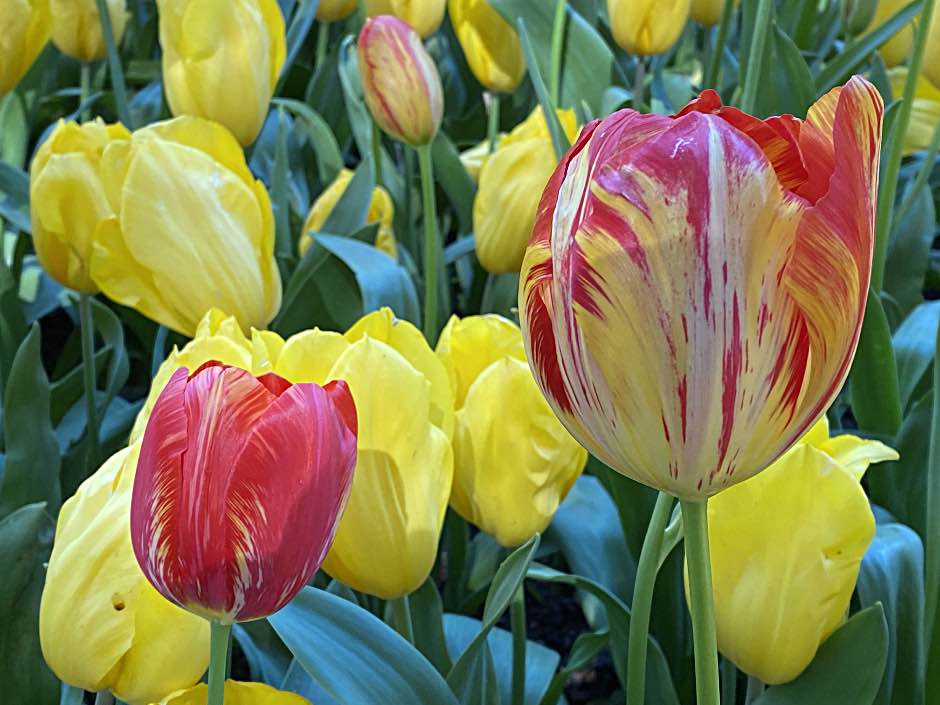
|
|
Where does one start and finish with photographing the tulips at Araluen?
Photo iPhone 11 Pro, 4.25mm (standard) lens, 2022/09/27 |
Photo iPhone 11 Pro, 6mm (telephoto) lens, 2022/09/27
The fact that it shows another aspect of Araluen beyond just the flowers is a bonus.
Photo iPhone 11 Pro, 6mm (telephoto) lens, 2022/09/27
Photo iPhone 11 Pro, 6mm (telephoto) lens, 2022/09/27 |

|
I include the photo here as a curiosity. Is the yellow natural? If so, what would cause it? Or was it painted on? If so, for what purpose? Much later, in March 2024, I came across bright yellow lichen in what I call the Big Seasonal Paperbark Swamp in Erskine, a Mandurah suburb; see the photo below.
Photo iPhone 11 Pro, 6mm (telephoto) lens, 2022/09/27
I suspect that this lichen is probably the yellow on the photo above taken in Araluen Botanic Park. The small dark green buttons left of centre are interesting. Possibly very small lichen plants?
The photo was taken using a Canon Ixus 190 pocket camera. It covers and area about seven centimetres across.
A couple of my granddaughters in the centre.
Photo iPhone 11 Pro, 4.25mm (standard) lens, 2022/09/27
Kings Park, Perth
The Subiaco Giant, one of the Mandurah Giants, is not far from Kings Park.
Photo iPhone 11 Pro, 6mm (telephoto) lens, 2022/09/30
Photo iPhone 11 Pro, 4.25mm (standard) lens, 2022/09/30
Photo iPhone 11 Pro, 4.25mm (standard) lens, 2022/09/30
Photo iPhone 11 Pro, 4.25mm (standard) lens, 2022/09/30
Lake Clifton Thrombolites
I have written at a little more length about the significance of the thrombolites on another page on this site. Photos on that page show them at a lower tide, when they were partly exposed above the water.
Photo, iPhone 11 pro, wide angle lens, 1.45mm focal length, 2022/12/02
A bit of the ugly side
I walk through this area when I have to wait for someone, either from the adjacent Riverside Primary School or from the medical centre. I came across this on 2022/05/09 and was shocked and disgusted at the amount of rubbish scattered about. I normally have a lot of sympathy for anyone who has to sleep rough, but whoever has this camp should be thoroughly ashamed of him/herself for this mess. We all make some sort of a contribution to the society in which we live. And we should all make an effort for that contribution to be positive, rather than this very negative contribution. Photo iPhone 11 Pro, normal camera (focal length 4.25mm) |
|
|
Related pagesOn this site...
Bowman Park, Crystal Brook, SA Climate change, the world's greatest threat and challenge
Contibuting to our communities Crystal Brook's Central Park, SA Destruction of roadside vegetation by a body that should be protecting it
A list of my Australian photo gallery files Peel Estuary and Mandurah - Observations
Why I support the local wind farm
Names and abbreviations I've used
|
|
|
IndexOn this page...Abbreviations and names I've usedArarluen Bandicoot Banksia victoriae blossom Black Swan Lake Reserve, Lakelands Drone images of Black Swan Lake Beaches, Mandurah Big seasonal paperbark swamp Kangaroos in the swamp Paperbark swamp through the seasons The swamp begins to fill Duckweed grows on the water in the paperbark swamp Duckweed close-up The Canals Dawesville Foreshore Reserve The Duck Pond Duckweed East side of main channel, Soldiers Cove, Mandurah Giants of Mandurah Coodanup Giant Coodanup Giant_mark_2 Dawesville Giant Halls Head Giant Lake Clifton Giant Marlee Reserve Giant Subiaco Giant Grasstrees (Xanthorrhoeas) Xanthorrhoeas in the big seasonal paperbark swamp Grey butcherbird Hardenbergia Just beyond my back yard Kings Park Lake Clifton Thrombolites Len Howard Conservation Park Kangaroos in Len Howard CP Osprey in Len Howard Conservation Park Mandurah centre Mandurah ocean beaches Mandurah Quay area, Peel Estuary Mandurah area generally Marlee Reserve Mount William My back yard Just beyond my back yard Names and abbreviations I've used Nankeen night heron New Holland Honeyeater Novara Beach Reserve, Peel Estuary Peel estuary Related pages Serpentine area, Peel Estuary Serpentine area on a smokey morning Shorebird or Waterbird? Spoonbill, yellow billed Sundew Swan family A bit of the ugly side Unnamed reserve behind our house Waterbird roosting area Xanthorrhoeas in the big seasonal paperbark swamp Xanthorrhoea leaves |